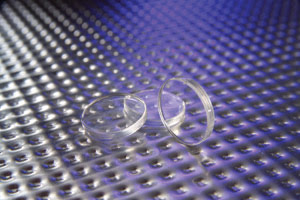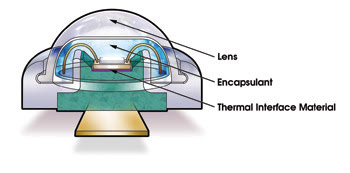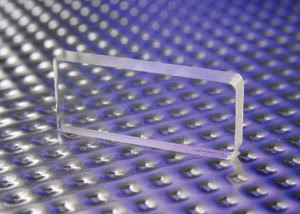Ongoing advancements pave the way for high-power LEDs in broader application areas.
Linda Kastilani, Dow Corning Corp.
High-brightness LEDs are increasingly being used in applications such as signs and displays, cell phone flash modules, automotive lighting and general illumination. Newer applications, however, such as solid-state lighting, and backlighting for flat panel LCD monitors and TVs, require higher-brightness LEDs that also run hotter and operate at higher wavelengths, thus placing new demands on packaging materials.
As a result of greater challenges being placed on materials, silicones are emerging as a material of choice for high-brightness LED packaging. Silicones deliver electrical, mechanical and thermal performance unmatched by organic formulations, and they have a long history of service in semiconductors and device packaging. They also are well-known for their stability, longevity and stress-relieving properties.
In the past, epoxies and cyclo-olefin copolymers were used to seal LEDs, but these materials cannot withstand the increasingly high reflow temperatures required for newer lead-free solders. And because of the high junction temperatures of blue emission, epoxies and copolymers are susceptible to yellowing.

Figure 1. These molded parts are made of silicone hard resin at a refractive index of 1.53 and with high optical clarity.
Silicone material can be formulated into several useful forms for LED applications, including gel and elastomer encapsulants. They also can be designed to cure as hard, durable solids and are now in commercial use as molding materials for fabricating discrete LED lenses (Figure 1). In fact, their versatility allows package designers to tailor the modulus to obtain the optimum hardness for virtually any given application, while maintaining optical transparency. Wire bond packages typically require more flexibility to relieve stress, for example, while molded lenses often demand a rigid, abrasion-resistant material (Figure 2).

Figure 2. Silicone is one of the only materials that can survive temperatures from –40 to 260 °C, which is required for lead-free solder reflow.
Light extraction
A critical feature of new silicone materials designed for LED applications is light extraction. When applied as encapsulants or used as lenses in LED designs, silicones deliver some of the highest optical transmission values of any polymeric material, with a versatile array of products that can be formulated to provide a refractive index ranging from 1.40 to 1.58. By closely matching the refractive index of the silicone to that of the substrate, LED designs can minimize interfacial losses. This combination of clarity and matched refractive index contributes to increased light output and improved lumen maintenance.
Processing is another critical element to material selection. Surface-mount technology is expected to become the norm for manufacturing LED assemblies. Wire bonding had been the preferred method, but it now has significant limitations, particularly as device sizes continue to shrink and applications require robust packaging. Because surface-mount technology, proven in the semiconductor industry, is a good packaging fit with small devices and boards such as high-brightness LEDs, encapsulants and other materials will be required to exhibit optical and mechanical stability after exposure to lead-free solder reflow temperatures of 260 °C. This temperature is much hotter than the melting point required for older, lead-based solder.
Organic materials are generally unable to withstand such high heat, which has been the demand source for more thermally stable options. Silicone is one of the only materials that can endure such harsh conditions while maintaining clarity and physical integrity. Protective materials based on silicone chemistry are typically applied to LED packages and modules with conventional dispensing and casting techniques (Figure 3).

Figure 3. Silicones deliver some of the highest optical transmission values of any polymeric material. By closely matching the refractive index of the silicone material to that of the substrate, LED designs can minimize interfacial losses.
Besides packaging applications, high-clarity formulations have been developed for manufacturing high-brightness LED lenses because silicones are well-adapted for precision molding. Micrometer-size features can be consistently replicated on the lens surface for directing light output and minimizing heat buildup, allowing the fabrication of lenses that can deliver specific light intensities and distribution patterns. Silicones have been proved effective in liquid injection molding processes that allow manufacturers to attain excellent production yields and cost efficiency.
Reliability
Device reliability and longevity in high-brightness LEDs depend heavily on the performance of the packaging materials. Among the most prominent advantages of silicone over its organic competitors is outstanding photo- and thermal stability. Epoxy, polycarbonate and cyclo-olefin copolymers may provide stable light output at junction temperatures up to 120 °C, but higher heat fluxes in new LED designs are pushing junction temperatures to 180 °C and beyond.
These escalating demands are pushing organic materials beyond their physical limits. Organics are prone to yellowing when exposed to high flux, partly because of the heat generated within the system, which leads to oxidative degradation and decreased transmission of visible light. The gap becomes more acute as efficiency improvements lead to the commercialization of higher-flux chips that can be driven at higher currents, with further elevated junction temperatures.
Benefits of silicone
In contrast, silicone is one of the few material chemistries that can withstand exposure to solder reflow temperatures of up to 260 °C for short duration during processing and to high junction temperatures in service without significant degradation of physical or optical properties.
Another important feature in improving device reliability is moisture resistance. By nature, silicones are hydrophobic; that is, they do not easily absorb water molecules. Yet their gas permeability allows any trapped moisture vapor to escape, thus eliminating a potential source of corrosion (or adhesion problems in protective materials). Silicones for LED applications can be supplied with very low ionic impurity levels.
Higher junction temperatures are driving manufacturers to investigate novel ways of removing heat from high-brightness LED assemblies. Transistor reliability and longevity are directly dependent on junction temperature, and reductions as small as 10 to 15 °C can almost double device life.
As part of the efforts to eliminate heat from electronic assemblies, significant strides have been made in the development of silicone thermal interface materials, which are essentially a thermally conductive pathway between a heat source and some other surface or medium (such as a heat sink or ambient air). Thermal interface materials have been produced in a variety of physical forms that may be valuable in LED designs, including thermally conductive adhesives, gap fillers, gels and encapsulants, as well as dry, prefabricated pads and even phase-change materials that shift from a solid to a liquid at a specific temperature.
A number of trends are driving the development of new materials for high-brightness LEDs. Silicones allow greater performance from packaging and lens materials without sacrificing clarity and are likely to continue to play a key role in meeting current and future needs.
Meet the author
Linda S. Kastilani is an electronics industry specialist at Dow Corning Corp. in Newark, Calif.; e-mail: [email protected].